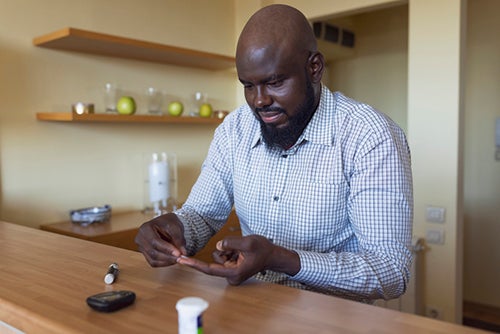Diabetes in Adulthood with Melissa Capps, RN
March 4, 2024The sugar, Mr. D, Mellitus and sweet blood are just a few monikers for type 2 diabetes, often diagnosed in adulthood. While these nicknames may trivialize this condition, the fact is that both Type 1 and Type 2 diabetes can significantly impact a person's life if left untreated.
According to the American Diabetes Association, "In 2021, 38.4 million American adults, or 11.6% of the population, had diabetes. Of the 38.4 million adults with diabetes, 29.7 million were diagnosed, and 8.7 million were undiagnosed."
 An alarming number of people are dealing with this disease, yet many of these individuals don't even know it, so they are not treating it. That in mind, we sat down with Melissa Capps, a WakeMed diabetes educator since 2003, to learn more about this condition — where misconceptions abound and many suffer unknowingly.
An alarming number of people are dealing with this disease, yet many of these individuals don't even know it, so they are not treating it. That in mind, we sat down with Melissa Capps, a WakeMed diabetes educator since 2003, to learn more about this condition — where misconceptions abound and many suffer unknowingly.
Early in Capps' career, she noted the prevalence of diabetes and made it her mission to help sufferers. She now works in WakeMed Adult Diabetes Management and brings awareness and strategies to help patients lead fulfilling lives despite the condition. She triages patient consults, performs extensive chart reviews and offers education to inpatients.
What is Type 1 diabetes?
Type 1 diabetes is an autoimmune disorder. Essentially, the body's immune system decided the pancreas was a threat or an outsider, so it dispatched warriors to shut it down. People with Type 1 diabetes do not make insulin, and it typically occurs in people less than 30 years of age, with high-incidence occurring during puberty. Type 1 diabetes can be diagnosed in later adulthood with adults who have a family history of another autoimmune disorder or Type 1 diabetes being the most likely candidates.
Type 1 affects more people who are Caucasian.
Type 1 is now known to be a genetic disorder. It occurs more often above the equator and in colder months. Occasionally, it presents following a viral infection.
What is Type 2 diabetes?
Type 2 diabetes has a much slower onset than Type 1. It typically happens in people over the age of 40, though it is trending toward diagnoses in younger people.
Type 2 diabetes happens because the pancreas wears out due to over-producing insulin for many years (10-15), as a result of insulin resistance at the cellular level.
How do they differ?
Mechanism of onset is the defining difference. In Type 1 diabetes, the pancreas is shutdown by the immune system. In Type 2 diabetes, the pancreas is shutdown as a result of overworking for an extended period.
Auto-antibodies can be tested to determine if someone has Type 1 or Type 2.
Type 1 is a bit more difficult to manage because the blood sugar is much more variable. It takes a lot less insulin to produce euglycemia and hypoglycemia.
Are Type 1 or Type 2 diabetes preventable?
It's tricky to determine if Type 1 or Type 2 diabetes can be prevented. While lifestyle modifications, such as healthy eating, maintaining a healthy body mass index and engaging in physical activity can delay the onset of diabetes, it is not clear if healthy choices can completely prevent onset.
A lot of stigma centers around diabetes because many believe it results solely from lifestyle choices, but this is not necessarily the case.
What are the signs of this disease and how is it diagnosed?
Hallmark symptoms of diabetes include the following:
- Exhaustion
- Depressed mood
- Extreme thirst and/or hunger
- Weight loss
- Muscle cramps
- Increased urination
Providers diagnose diabetes through a blood glucose test that measures sugar levels in the blood stream.
How are Type 1 and Type 2 diabetes treated?
Type 1 diabetes is regulated specifically with insulin and sometimes with incretins.
Type 2 diabetes is treated with diet, lifestyle modifications, oral medication and non-insulin injectable medications, such as incretins and insulin.
According to the American Diabetes Association, target blood sugar is 80 to 130 mg/dL before meals and always less than 180. Low blood sugar (less than 80 mg/dL) is treated with sugar, such as 15 grams of carbohydrates. Examples include four ounces of juice, six ounces of non-diet soda or eight ounces of low fat milk.
High blood sugar is often treated with insulin, which is a hormone that is produced by the pancreas to move sugar from the blood stream into cells and tissues. The sugar is then burned as fuel for that particular cell, so it can do it's job. High blood sugar can also be treated through hydration or oral medications.
If blood sugar goes above 400 mg/dL, patients should head to the emergency department, unless they have been taught by their provider how to handle it since various medications and type of diabetes could determine appropriate treatment.
What do adults need to know about diabetes and exercise?
Exercise helps burn the sugar that is currently in the cells to make room for more sugar to be burned. Thirty minutes of exercise, such as walking, can help control blood sugar for approximately 24 hours.
What do adults do if they forget to take the long-acting insulin?
If those taking long-acting insulin forget to take the medication, they should take it as soon as they remember and then set the new time to take it daily. Most long-acting insulin lasts for about 24 hours once injected.
Can people with diabetes take cold medications?
Yes, people with diabetes can take cold medications. They should monitor themselves for dehydrating effects and the grams of total carbohydrates in some medications.
How do patients contact the manufacturer for the blood glucose meter or pump?
If someone is wearing a pump, he or she should contact customer support for that particular brand. Sometimes, the pumps even have 1-800 numbers posted on the back of them, just like blood glucose meters. Usually, pump trainers will provide the pump wearer that information for 24-hour-per-day, seven-day-per-week, year-round assistance.
What educational opportunities do you offer through WakeMed?
The Diabetes Resources team, Diabetes Support Group and Nursing Education have educational opportunities created by diabetes educators.
Our caring, experienced staff of certified diabetes nurses and registered dietitians can provide the tools you need to manage diabetes on a daily basis. We are here to help you learn to control your diabetes by eating healthy, exercising and taking your medications properly.
We offer education, support and a variety of outpatient services tailored to meet your needs, your lifestyle and your schedule, as well as inpatient services, if you need to be in the hospital. Services are available at Cary Hospital, Raleigh Campus and WakeMed North.
An an ADA-Recognized Quality Diabetes Education Program, we follow the national standards for diabetes self-management and education.
Call 919-350-7292 for more information.
